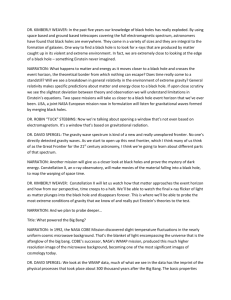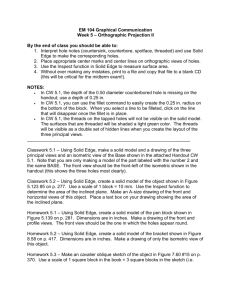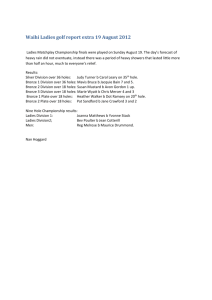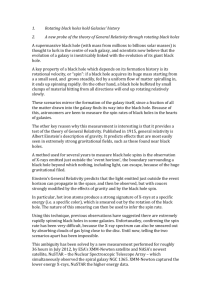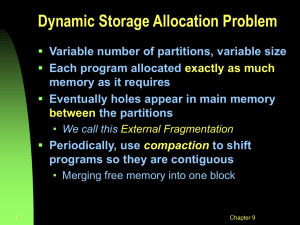A BLACK HOLE IS NOT A HOLE Written by CAROLYN
advertisement
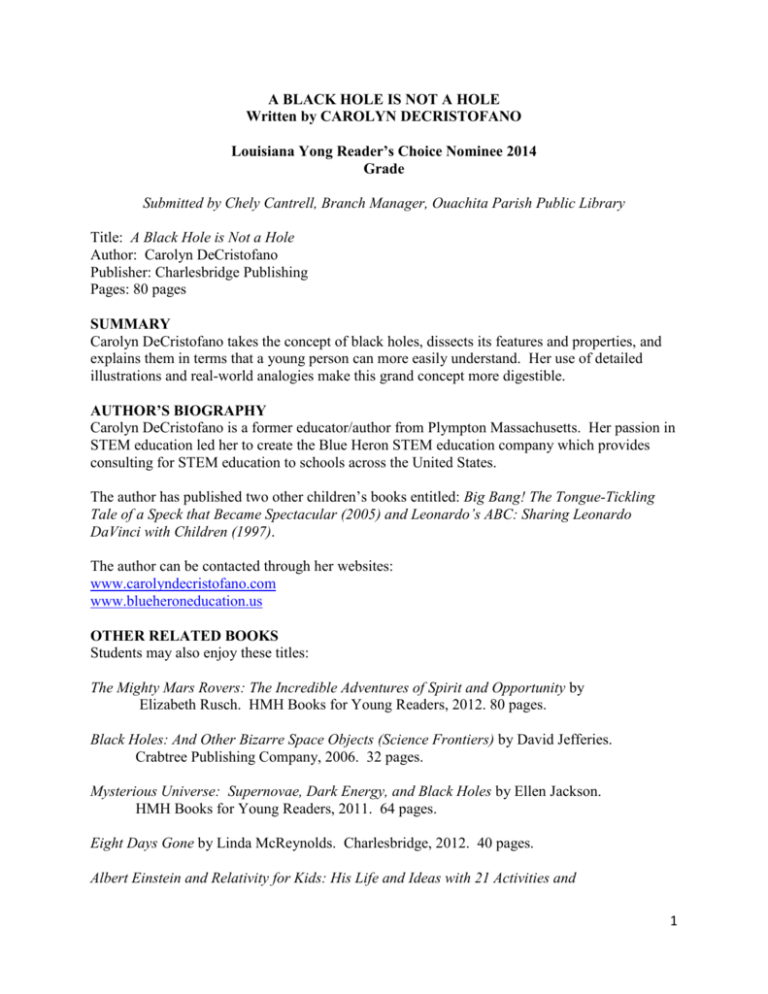
A BLACK HOLE IS NOT A HOLE Written by CAROLYN DECRISTOFANO Louisiana Yong Reader’s Choice Nominee 2014 Grade Submitted by Chely Cantrell, Branch Manager, Ouachita Parish Public Library Title: A Black Hole is Not a Hole Author: Carolyn DeCristofano Publisher: Charlesbridge Publishing Pages: 80 pages SUMMARY Carolyn DeCristofano takes the concept of black holes, dissects its features and properties, and explains them in terms that a young person can more easily understand. Her use of detailed illustrations and real-world analogies make this grand concept more digestible. AUTHOR’S BIOGRAPHY Carolyn DeCristofano is a former educator/author from Plympton Massachusetts. Her passion in STEM education led her to create the Blue Heron STEM education company which provides consulting for STEM education to schools across the United States. The author has published two other children’s books entitled: Big Bang! The Tongue-Tickling Tale of a Speck that Became Spectacular (2005) and Leonardo’s ABC: Sharing Leonardo DaVinci with Children (1997). The author can be contacted through her websites: www.carolyndecristofano.com www.blueheroneducation.us OTHER RELATED BOOKS Students may also enjoy these titles: The Mighty Mars Rovers: The Incredible Adventures of Spirit and Opportunity by Elizabeth Rusch. HMH Books for Young Readers, 2012. 80 pages. Black Holes: And Other Bizarre Space Objects (Science Frontiers) by David Jefferies. Crabtree Publishing Company, 2006. 32 pages. Mysterious Universe: Supernovae, Dark Energy, and Black Holes by Ellen Jackson. HMH Books for Young Readers, 2011. 64 pages. Eight Days Gone by Linda McReynolds. Charlesbridge, 2012. 40 pages. Albert Einstein and Relativity for Kids: His Life and Ideas with 21 Activities and 1 Thought Experiments by Jerome Pohlen. Chicago Review Press, 2012. 144 Pages. 13 Planets: The Latest View of the Solar System by David A. Aguilar. National Geographic Children’s Books, 2011. 64 pages. Super Stars: The Biggest, Hottest, Brightest, and Most Explosive Stars in the Milky Way by David A. Aguilar. National Geographic Children’s Books, 2010. 48 pages. Black Holes by Ker Than. Scholastic, 2010. 48 pages. CLASSROOM CONNECTIONS ART Abstract art is defined as art that does not attempt to represent external, recognizable reality but seeks to achieve its effect using shapes, forms, colors, and textures. Ask students to create abstract art of what they think the inside of a black hole looks like. They can use a variety of media (pastel, charcoal, torn paper, fabric scraps, clay, marker, chalk, etc) to achieve their vision on a canvas panel. Have them write a brief one paragraph description of the meaning of their piece. MATH In 2004 NASA released a series of educators guides on “space math” one of the sections of this was “black hole math”. This link is for a complete PDF packet of different detailed math projects for grades 6-8 that can be used dealing with Black Hole Math. http://www.nasa.gov/pdf/377674main_Black_Hole_Math.pdf SOCIAL STUDIES Discuss Stephen Hawking’s latest theory that Black Holes are Actually Gray. http://www.nbcnews.com/science/stephen-hawking-shakes-theory-again-blackholes-are-actually-gray-2D12001605 This can segue into a discussion about America’s unending fascination with new scientific discoveries having to do with space. Why are his discoveries still so popular that they make national news? Why are people so fascinated with space exploration? ENGLISH DeCristofano’s book is an example of interesting and engaging non-fiction. Assign students with the task to pick a favorite non-fiction subject (scientific, social studies, history, etc) have them write an information essay that not only informs the reader about their subject matter but also entertains the reader with interesting facts. SCIENCE Discuss how the Hubble space telescope has helped scientists discover and study black holes. What identifying factors have led to these discoveries? 2 Stand a vacuum hose upright and attach it to the side (at level) of a desk. Use a ball covered in flour and orbit the ball near the hose using a tether. As you swing the ball in a circular motion around the hose students can see how the flour is sucked into the vortex. You can use the motion and the orbit of the ball to show students that the ball will not necessarily be drawn directly into the hose depending on its orbital position and its speed. Visit sites such as NASA, Hubblesite.org, and spacetelescope.org for further resources. DISCUSSION QUESTIONS Questions are from – Discovery Education – Black Holes: the Great Abyss – lesson plan http://www.discoveryeducation.com/teachers/free-lesson-plans/black-holes-the-ultimateabyss.cfm 1. Discuss how Newton’s view of gravity differs from Einstein’s view of gravity. 2. Describe how a black hole is formed from the time a massive star begins its collapse. 3. Knowing that density is defined as mass per unit volume, discuss the mathematical characteristics of a singularity (values of mass, density, volume, and radius). 4. Describe the steps involved in determining the mass of a black hole. What do you have to measure or observe in order to estimate the mass? 5. If you were observing a probe entering the event horizon of a black hole, you would see it “hovering for an eternity and destroyed in an instant.” Discuss the meaning of this phrase as it applies to conditions near a black hole. 6. Discuss the objective of the Gravity Probe B satellite and its relevance to the study of gravity. RELATED WEBSITES NASA Space Education – Black Holes http://spaceplace.nasa.gov/black-hole-rescue/en/ Discusses what black holes are and what different kinds there are. NASA Goddard Space Flight Center – Black Holes http://imagine.gsfc.nasa.gov/docs/science/know_l2/black_holes.html Discusses what black holes are and the science behind how we know they are there. Black Hole Educator Guide – NASA Education and Public Outreach Group http://www.spokanefalls.edu/resources/Planetarium/_docs/Black%20Holes%20educator's%20gu ide.pdf Although this guide was designed to accompany the viewing of a planetarium show it has useful activities that can be used in conjunction with A Black Hole is Not a Hole. Frequently Asked Questions about Black Holes – Virginia Tech Physics http://www.phys.vt.edu/~jhs/faq/blackholes.html Virginia Tech physics department answers questions frequently asked about black holes. These questions could be used to prompt discussion in class. 3 Greetings from Nowhere – Interview with Carolyn DeCristofano http://greetings-from-nowhere.blogspot.com/2012/02/carolyn-decristofano-is-in-house.html Blogger interviews author of A Black Hole is Not a Black Hole. Author gives her response on what inspires her to write science based children’s books and shares information about her writing and research process. Black Holes Gravity’s Relentless Pull – Hubble Site http://hubblesite.org/explore_astronomy/black_holes/ This site features a brief video introduction to the basic concept of a black hole. Site also features an interactive journey to a black hole and a black hole encyclopedia that answers questions, has a glossary, and features short experiments. 4

